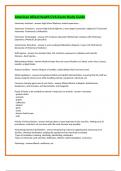American Allied Health CVA Exam Study Guide
Veterinary Assistant - answer-High School Diploma; animal experience...
Veterinary Technician - answer-High School Diploma; 2-year degree (associate's degree/LVT [Licensed
Veterinary Technician] Certification)
Veterinary Technologist - answer-LVT-continue education OR Bachelor's Degree with Veterinary
Experience (Medical Lab Specialist)
Veterinarian: Education - answer-4 years undergrad (Bachelors Degree), 4 years Vet Med School
(Doctorate of Veterinary Medicine)
Staff Injuries - answer-Can include: bites, fall, scratches, exposure to radiation and zoonotic
diseases...back injuries...
Biohazardous Waste - answer-Medical waste that can cause infection; ex: blood, urine, feces, tissues,
needles, scalpel blades
Sharps Container - answer-Dispose of needles, scalpel blades that have been used.
OSHA regulations - answer-Occupational Safety and Health Administration; ensuring that the staff are
always using the utmost care while handling animals, equipment, chemicals, etc
Common cleaning agent used in vet clinics - answer-Diluted bleach, antiseptic, disinfectants,
deodorizers, anti-virocides, anti-bactericides, anti-fungicide
Foods & Plants to be avoided by animals- Foods toxic to animals - answer--chocolate
-grapes/raisins
-avocado
-grapes
-coffee/tea
-alcohol
-garlic
-onion
-human food/scraps
-milk
Priority of Animal Safety - answer-Animal safety is most important in the vet clinic. Making sure all
procedures, restraints, etc are done with the most humane way possible.
Autoclaving/chemical sterilization - answer-Autoclaving is done by applying heat and pressure to
sterilize. Chemical sterilization: putting the equipment into chemicals to sterilize
Types of sanitation: cleaning, sterilizing, disinfecting, antiseptics
Types of chemicals used: alcohols, aldehydes, chlorine, iodine/iodophors, ammonias
Poisonings - answer-Bleach, antifreeze, etc
, SDS Safety Data Sheet - answer-Lists the use ingredients, how to store, etc of ALL chemicals in vet
clinic/other business
Nosocomial infections - answer-Infection/disease acquired at a hospital
Zoonotic infections - answer-Disease/infection passed from animals to humans (ex: rabies, scabies,
ringworm)
Clostridial infections - answer-Infection caused by the clostridia bacteria (ex: tetanus and botulism)
Signs of Animals in Distress - answer-[Tail between legs, hair standing up] Poor vital signs, white/pale
gums, dehydrated, could be bleeding, respiratory distress-needing CPR, foreign object in airway or
eyeball or body, low temperature, coughing/wheezing, may have a broken limb
Veterinary Dentistry - answer-Parts of the tooth, periodontal disease/gingivitis, dentistry tools: scaler,
ultrasonic scaler, toothbrush, x-ray, removal of teeth if needed
Veterinarian Radiation - answer-X-ray, dosimeter, X-rays normally done to view bones-but can be done
to view any other area (ex: abdomen [air or foreign objects] and chest)
Complications - answer-Exposure to radiation of the technician/veterinarian, poor view of animal-not be
able to diagnose, animal could not cooperate for an x-ray
Metric Conversion - Weight - answer-Always measured in LBS or KG
Metric Conversion (dosages/conversions) - Measurements - answer-Height, Temp, Respiration rate,
heart rate, (vital signs)
Metric Conversion (dosages/conversions) - Vaccines - answer-Common vaccines: Kennel cough, Parvo,
Rabies, Distemper, Lymes; done on a vaccine schedule (refer to your vaccine chart)
Metric Conversion (dosages/conversions) - Injections- Modes of administering - answer-Nasal, Oral, IM,
IP, IV, Sub-Q
Metric Conversion (dosages/conversions) - Sites For Injections - answer-Nasal-nose, Oral-mouth, IM-in
muscle, IV-in vein, IP-in abdomen, Sub-Q-under skin (neck/shoulder/arm pit region)
Common Venipuncture Sites - answer-Cephalic- forearm, Jugular- neck (2 jugular veins),
Femoral/Saphenous- inner thigh
Specimen Collection - answer-Urine- direct urine sample (insert a needle into bladder and draw urine) or
catch method (cup and a stick)
Blood- via needle/syringe
Fecal- collected immediately after animal relieves itself




